The below post may contain affiliate links. This means we will receive a commission if you purchase through our link, with no extra cost to you. As an Amazon Associate we earn from qualifying purchases. Read our full disclaimer.
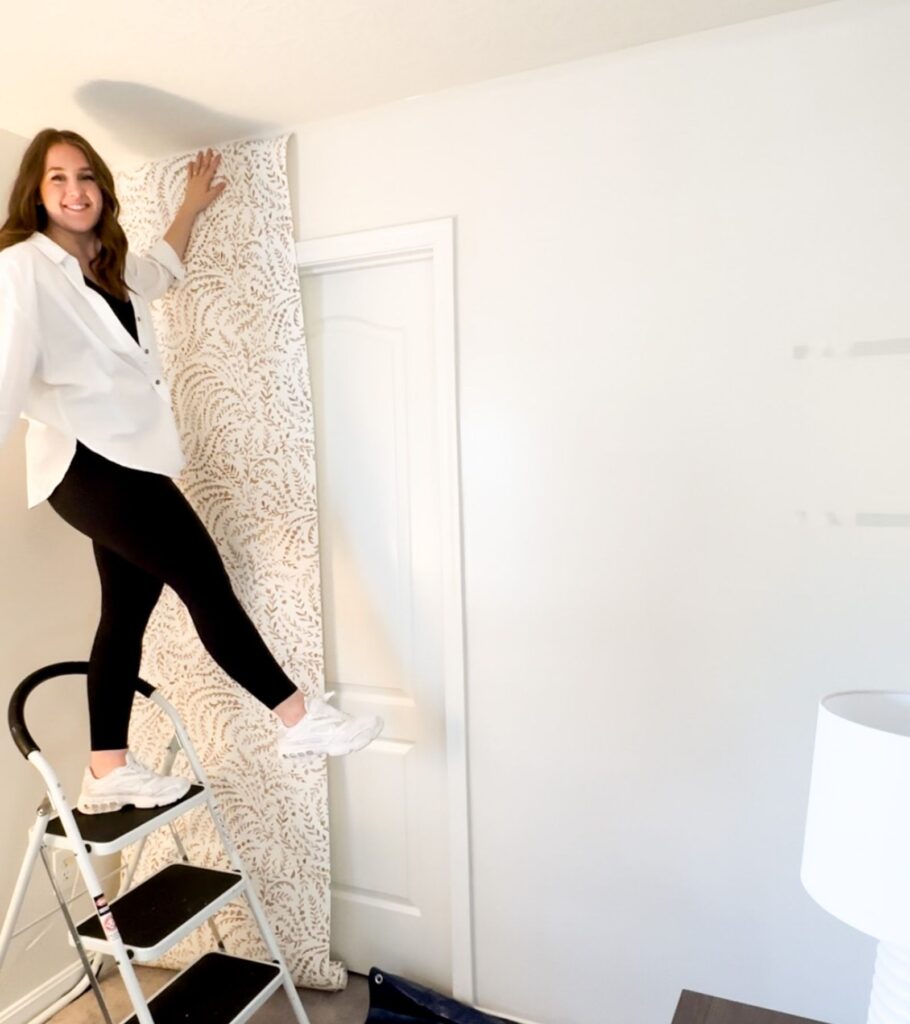
Wallpaper is an easy way to add an eye-catching and unique focal point to a room. It doesn’t matter whether you are doing just a single wallpaper accent wall, or covering every wall from top to bottom with it, wallpaper is sure to make your space POP!
But, the big question we’re all here for is: which is the best type of wallpaper – peel and stick or traditional?
I have used wallpaper 5 different times in my house (2 being peel and stick, 3 traditional), so I’m able to shine some light on my experience and which is the best option for you!
In this post, you’ll learn the pros and cons of both, and a little more detail to make your life easier during the wallpapering process! Let’s start with peel and stick.
Peel and Stick Wallpaper
Peel-and-stick wallpaper, or self-adhesive wallpaper, is probably the most popular and most advertised type of wallpaper to DIYers – plus, it’s usually the cheaper option.
It’s a simple concept – peel the backing off the wallpaper and stick it to the wall. The instructions are in the name! Easy right? Well, unfortunately, it’s a lot easier said than done. This doesn’t mean it’s necessarily difficult, but I’d be lying if I didn’t say it was frustrating.
Although this is kind of the story for wallpapering in general, in my experience, peel-and-stick wallpaper seems to strike the agitation nerve a couple more times than traditional does lol.
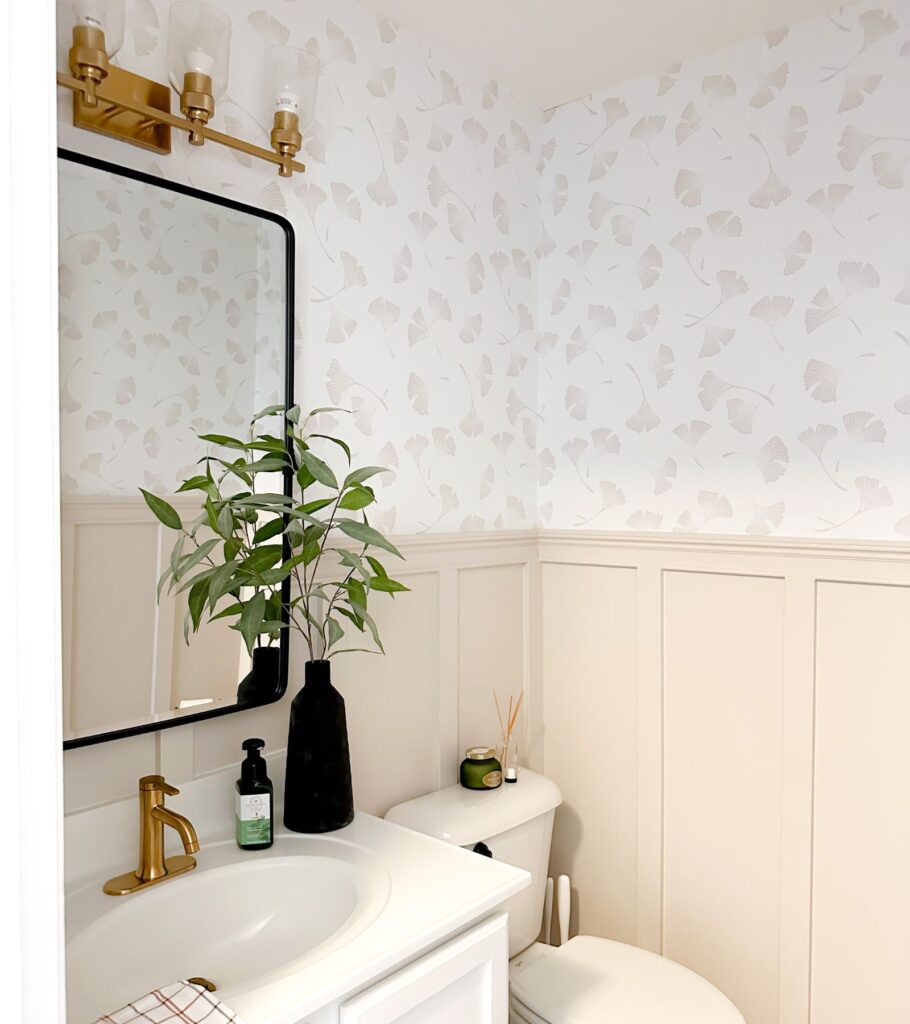
Peel and Stick Wallpaper Pros and Cons
Let’s first dive into a high-level view of the pros and cons of peel-and-stick wallpaper.
Peel and Stick Wallpaper Pros
- No prep work for the wallpaper itself
- Typically cheaper compared to traditional wallpaper
- DIY friendly
- Customizable
- Easier to remove
Peel and Stick Wallpaper Cons
- Adhesive back makes aligning and readjusting difficult and tedious
- Shows imperfections on the wall requiring some prep to walls
- Might need to paint the walls a light, neutral color before install
- More of a temporary option
- May peel some drywall paper upon removal
Prep Work for Peel and Stick Wallpaper
The good news is that there is essentially no prep work for the peel-and-stick wallpaper itself. No pasting involved here!
Although the wallpaper doesn’t need any prep, self-adhesive wallpaper tends to show more of the imperfections in your wall vs traditional wallpaper. So your wall might need to be prepped a little more.
I think the paste with traditional helps hide things a little bit better. But if you have noticeable imperfections on your wall such as dents, noticeable paint splatter, or bumps, you will see the imperfections once the wallpaper is installed – eek!
Now here’s something to consider – the more dense your pattern is on your wallpaper (if it’s flowing through every inch of the wallpaper), this isn’t going to be a huge issue. But if your pattern is light and spaced out, the “in-between” is where you’re going to see it.
I’m using my bathroom for an example – no shame here. 🙂 Just a learning experience for us all. I used a beautiful ginkgo self-adhesive wallpaper that has a lot of blank space between the pattern. I had a couple of places that looked like this.
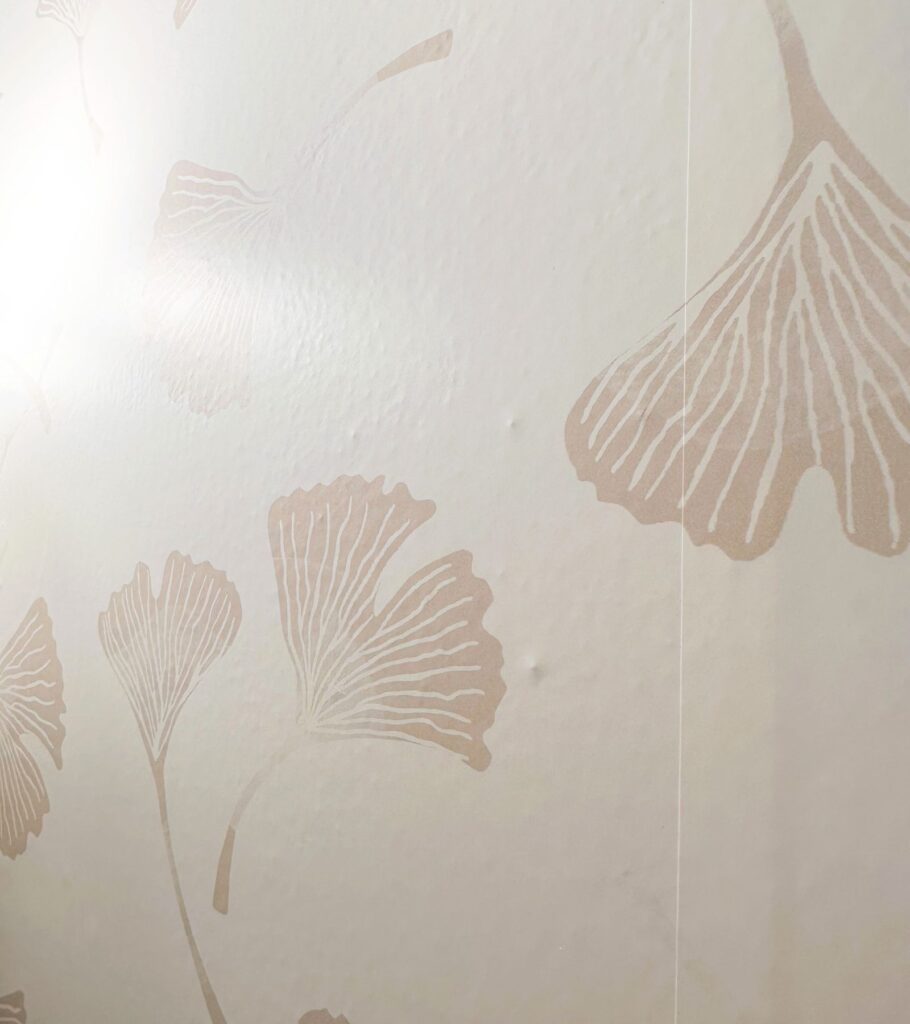
Obviously not the most attractive, but here’s the thing, your guests really are not going to notice! Plus it’s a small section on a large canvas, so you probably don’t need to worry too much – but this is a downside of peel-and-stick compared to traditional wallpaper.
Check out my post How to Fix a Dent in a Wall (Or Hole) – 3 Insanely Easy Steps! if you’ve got some prepping to do!
A wallpaper liner is another option for covering up imperfections! That’s really its main purpose. But also this is additional prep work.
Painting Prep
If your walls are a color other than white or neutral, depending on the material and color of your wallpaper, you may need to paint the wall white. I had a light blue bathroom prior to installing my ginkgo wallpaper and after installing it, I could tell that it made my wallpaper ever so slightly darker.
If you have wallpaper with a light background, your wall color may impact your final look. With my other peel-and-stick wallpaper experience, I didn’t have this issue because it was a different material, but I think the ginkgo wallpaper was just a tad bit thinner and lighter creating this effect.
Walking into my bathroom, you’d never know, but I know… and sometimes you just have to live with it! Just something to consider when it comes to the prep work.
RELATED POST: How to Fix a Dent in a Wall (Or Hole) – 3 Insanely Easy Steps!
Installing Peel and Stick Wallpaper
When installing peel-and-stick wallpaper, remember to take your time to get it perfectly lined up! Even if you think that a slight misalignment will be fine, trust me when all is said and done you will be able to tell if things aren’t as perfect as possible.
Depending on your wallpaper pattern or design, aligning each piece of wallpaper can be a little annoying. If you have a pattern that flows from panel to panel, this is especially true!
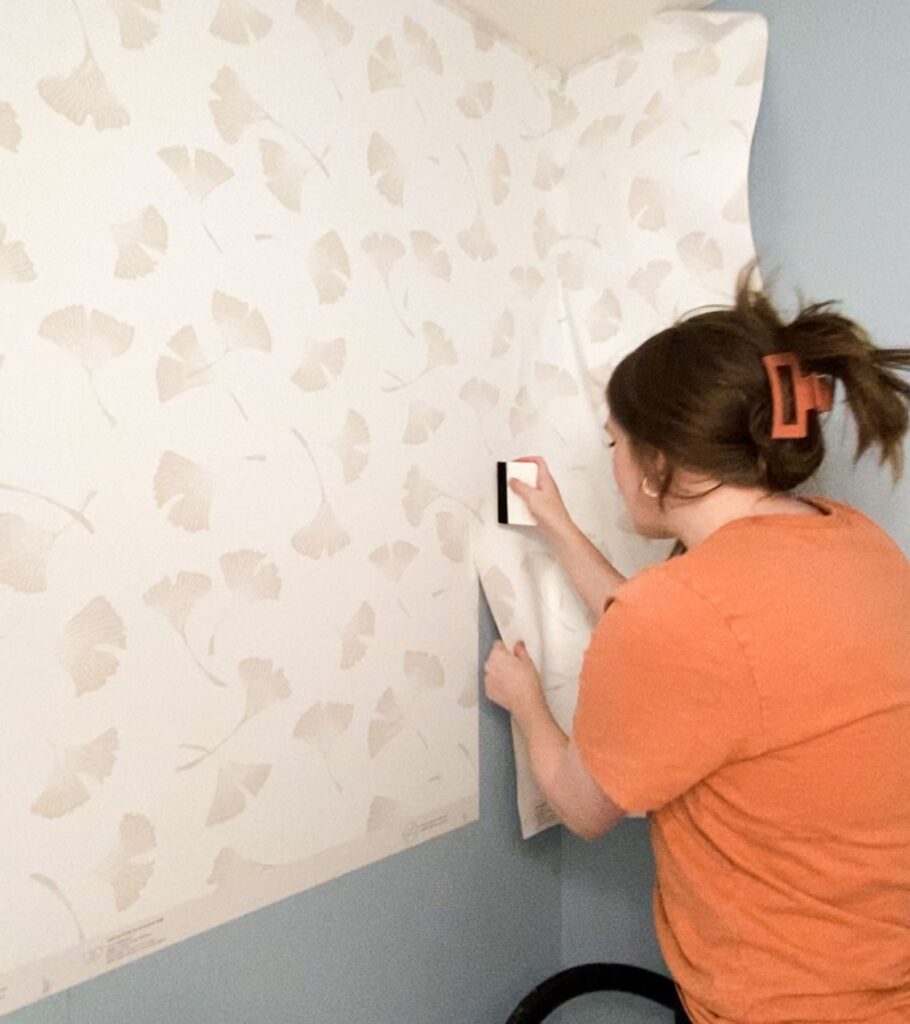
With self-adhesive wallpaper, because the back is already sticky, each time you go to readjust, you’ll have to unstick and stick it back to the wall over and over until it’s right. It’s not difficult, it’s just very tedious because the wallpaper wants to stick to the wall even when you just have to slightly readjust.
Personally, this is the thing I dislike most about peel and stick. When looking at peel and stick vs traditional wallpaper and what is the best type of wallpaper for your home, I much rather prefer traditional for the installation portion – I’ll tell you how this process differs in the traditional wallpaper section below!
The best tip I can give you for installing peel-and-stick is DO NOT UNPEEL THE ENTIRE SECTION. Unpeel as you go, that way you don’t have your entire piece sticking to the wall and creating chaos spanning the entire height of the wall.
So unpeel a little bit at the top, get it in position, and then unpeel another foot or so. This will make your life infinitely better if you’re going the peel-and-stick route.
If you can handle the tediousness then this might be the best type of wallpaper for you!
Check out the best wallpaper tools for installation at the end of this post. Or check out this kit on Amazon here!
Removal of Peel and Stick Wallpaper
Out with the old, in with the new! All good things come to an end and the wallpaper you once loved is no exception.
So what’s it like to take it down? It was actually really easy. Once you get a corner or edge peeled back enough with your fingers, just slowly peel it off the wall.
I actually replaced the self-adhesive wallpaper I originally installed in my laundry room. When we moved into our house years ago, I immediately hopped toward the shiplap look. I found a good one at Target and my mind was made up. Well, after we settled into our house, I realized it gave off a farmhouse kind of look that didn’t go with the aesthetic of the rest of my house.
RELATED POST: Very Small Laundry Room Ideas That Will Actually Make You Want To Do Laundry!
Luckily, peel-and-stick wallpaper is really cheap and it was a small wall, so no harm no foul. It was a very easy removal, but I will say that there were spots where it peeled off some of the drywall paper. This can be simply fixed with some DAP spackle, but it’s never fun to patch and wait until you can continue with your project!
Longevity of Peel and Stick Wallpaper
So how long does peel-and-stick wallpaper last? Some say a few years, others say as long as you need it to. If it’s going in a family room, laundry room, etc., I would say it can last a very long time.
It’s when you install it in full bathrooms that I think you might start seeing some issues with longevity. Why? Because bathrooms with showers get very humid and are constantly exposed to that kind of moisture when you take a shower or bath.
Because peel and stick is seen as a temporary solution (since it peels off the wall when it’s time for removal as easy as it sticks), it’s not expected to last forever. So keep that in mind when thinking about how long you want your wallpaper to last and if you see it in your future!
Customizability for Peel and Stick Wallpaper
There are SO many options out there for peel-and-stick wallpaper, and a lot of sites out there actually allow you to customize it completely!
That’s exactly what I did to get my ginkgo wallpaper in my small half-bathroom. You can customize the background color, and the pattern color – and that’s after sorting through hundreds of patterns you can choose from!
If you’re wondering where I got mine, it was from Love Vs. Design. I will say, the customizability you can do on this site is incredible. However, I didn’t like how the instructions require you to overlap the wallpaper.
To me, this makes the seams a little bit more noticeable, but again, if you’re not looking for it on your wall, then this may not matter to you. I like when wallpaper lines up perfectly edge to edge because it gives you the best-looking seam.
While there are lots of options out there for traditional wallpaper as well, they simply aren’t as customizable as peel and stick.
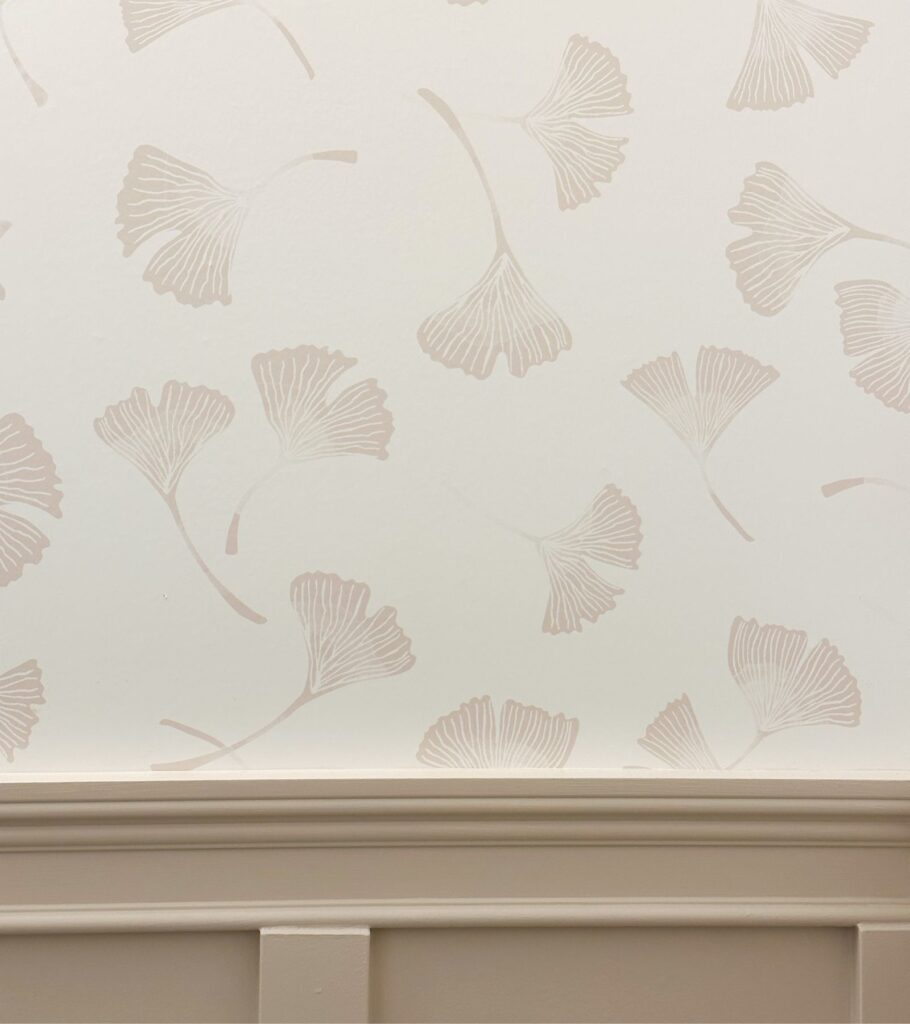
Best Places to Buy Peel and Stick Wallpaper:
- Target
- Amazon
- Love Vs. Design (for customizability purposes)
Traditional Wallpaper
Traditional wallpaper might seem like “the old way to do it” when compared to peel-and-stick wallpaper, however, it’s the more permanent way to do it. Also, it’s not as scary as it sounds!
Traditional wallpaper is the kind of wallpaper that requires paste to adhere to the wall. It’s also known as unpasted wallpaper. While this may be an extra step compared to self-adhesive wallpaper, it’s what, in my opinion, makes the process easier. I’ll tell it all in the installing section!
Priming with a wallcovering primer is also recommended for adhesion purposes and easy removal down the road.
Plus, it’s the only type of wallpaper I will ever install in my house because two times with peel-and-stick was enough for me haha. But I’ll let you decide what the best type of wallpaper is for yourself after reading through the pros and cons of both!
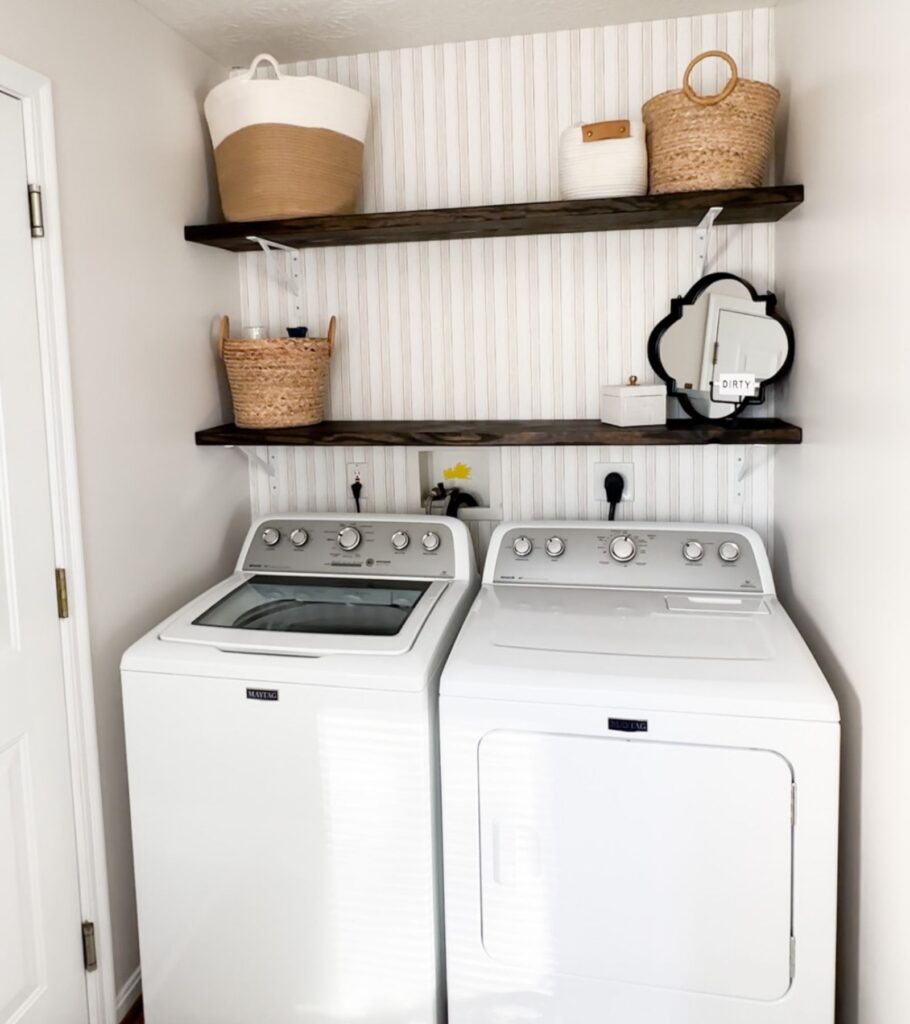
Traditional Wallpaper Pros and Cons
When looking at peel-and-stick vs traditional wallpaper, traditional also has its pros and cons. Let’s take a look at what these are before doing a deeper dive!
Traditional Wallpaper Pros
- Easier to adjust upon install
- More of a permanent solution for wallpaper
- Paste appears to cover small imperfections in the wall, so no need to patch or fix
- Higher quality and more expensive looking (because it is more expensive 😂)
Traditional Wallpaper Cons
- Pasting is an extra step and cost when compared to peel and stick
- It’s recommended to prime the wall with a wallcovering primer
- Usually a little more expensive
- Removal is more extensive
Prep Work for Traditional Wallpaper
Peel-and-stick wallpaper and traditional wallpaper both have a trade-off when it comes to prep work. As I mentioned previously, peel and stick’s prep is in the imperfections in the wall and possible painting.
With traditional wallpaper, the prep is priming the wall with a wallcovering primer. It goes on just like paint and is extremely easy to apply! This simply helps with adhesion purposes and makes for an easier removal down the road if you decide to ever take it down.
Without it, your wallpaper glue will bond to your drywall and then your removal process will be…not fun to say it nicely lol.
The best wallcovering primer that I’ve had experience with is Shieldz Universal Wallcovering Primer. However, at the time of writing this post, it seems to be a little bit more difficult to come across.
After doing some research, Roman PRO-977 Ultra Prime Pigmented Wallcovering Primer seems to be the best alternative and is more readily available at Home Depot! It’s just as good for adhering to wallpaper and preparing for removal in the future.
Installing Traditional Wallpaper
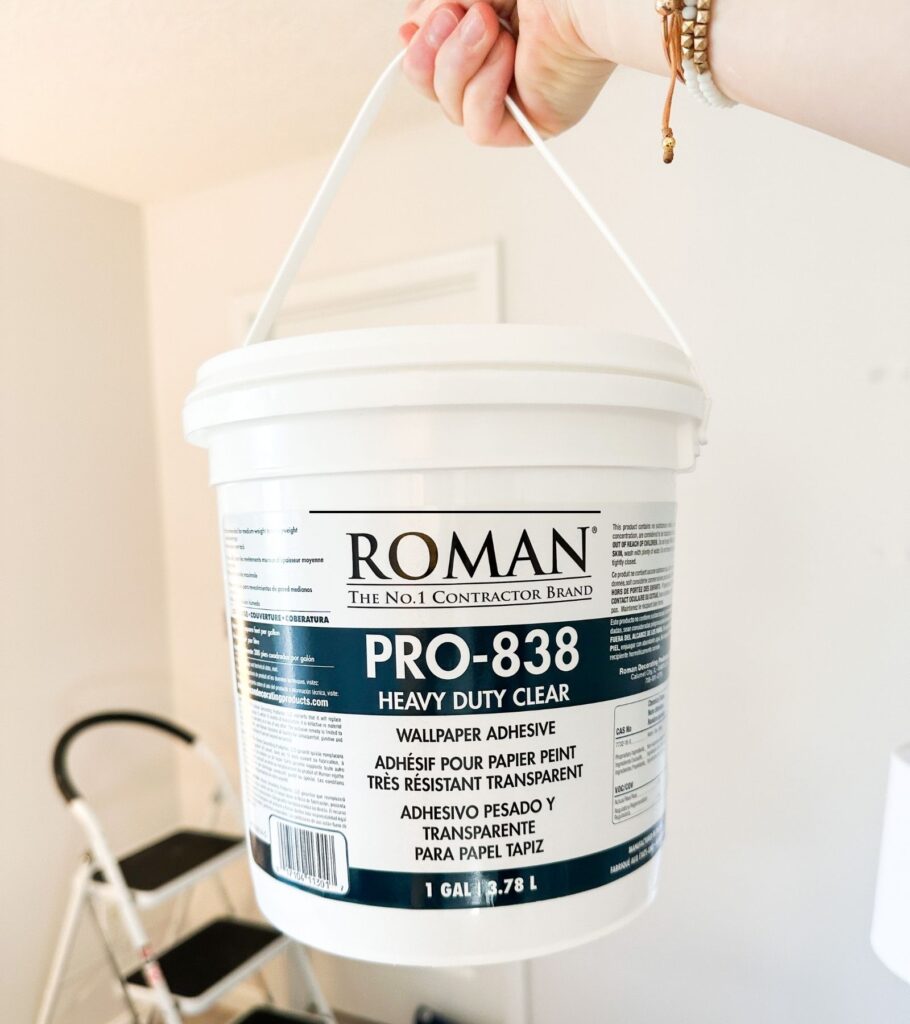
So how do you install traditional wallpaper if it’s not self-adhering? With paste of course!
This might be the intimidating step that immediately makes DIYers run for the peel and stick, but bear with me for 30 seconds!
You paint the paste, or glue, on just like paint (over the primer or on the actual wallpaper itself), and only for the section you’re putting up. Some say to paste the back of the covering first, but I find it much easier to just paste the section of the wall you’re working with. That way the piece of wallpaper isn’t curling in on its gluey self!
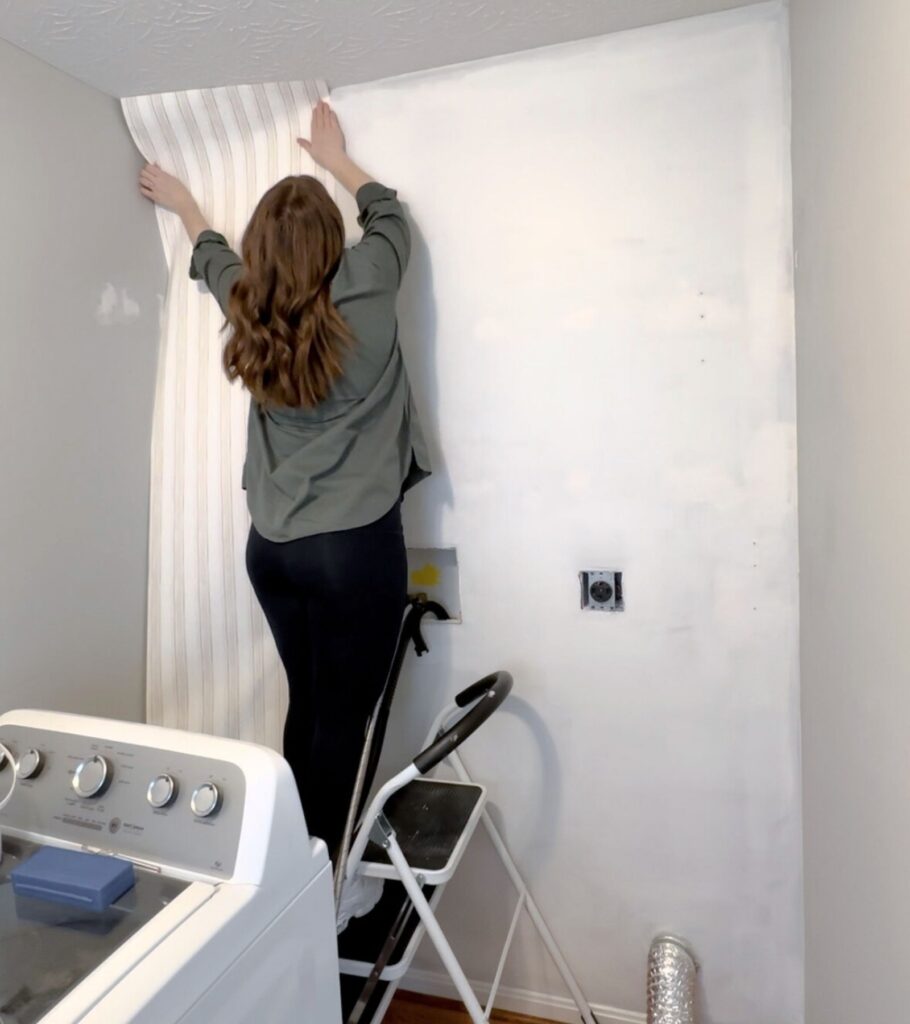
This next part is the reason I’m never going back to peel-and-stick wallpaper. When you need to readjust the wallpaper, it’s SO SIMPLE to just slide it slightly into place, or align it with the next piece. Remember, with peel and stick, you need to constantly unstick and stick it until it’s perfect.
The glue allows you to just smoothly shift it into place, and I LOVE that.
Plus in my experience, the glue helps cover small imperfections. I will say, it’s still worth patching and smoothing out the wall before applying wallpaper. And don’t forget wallpaper liner is a thing if that’s a route you want to go!
When looking at peel-and-stick vs traditional wallpaper, you will need a couple of tools. Check out the best wallpaper tools for installation at the end of this post. Or check out this kit on Amazon here!
Removal of Traditional Wallpaper
This is the only section I don’t have personal experience with – I have yet to personally remove traditional/unpasted wallpaper myself.
Although I do know the primer is setting me up for success, that is, if I ever choose to change my wallpaper later.
There are apparently plenty of hacks out there for the easiest ways to remove traditional wallpaper. When we’re talking about peel-and-stick vs traditional wallpaper, I think peel-and-stick takes the cake in this category.
I follow the Home RenoVision DIY channel on Youtube to get inspo on a lot of DIY ideas. I absolutely love this guy and he has a whole video on the easiest way to remove wallpaper using just a sponge and a putty knife. Check it out here! He makes it look easy – I sure hope I have the same experience haha. I know I will be rewatching this video years from now!
Longevity of Traditional Wallpaper
Traditional wallpaper is meant to be a much more permanent solution when compared to peel-and-stick wallpaper. Since you’re literally using paste/glue to adhere it to the wall, it’s bound to last for the lifetime of your home!
This type of wallpaper is also typically better quality than peel-and-stick, which is also why it’s more expensive. You’re paying for the quality and longevity.
Customizability for Traditional Wallpaper
It looks like the phrase “what you see is what you get” applies to unpasted, traditional wallpaper.
There are soo many companies out there that make traditional wallpaper, so I don’t think you’re going to have a hard time finding something you absolutely love.
However, if you are looking for something that is easier to customize for the background colors or patterns (like my Ginkgo wallpaper), peel-and-stick might be the better option!
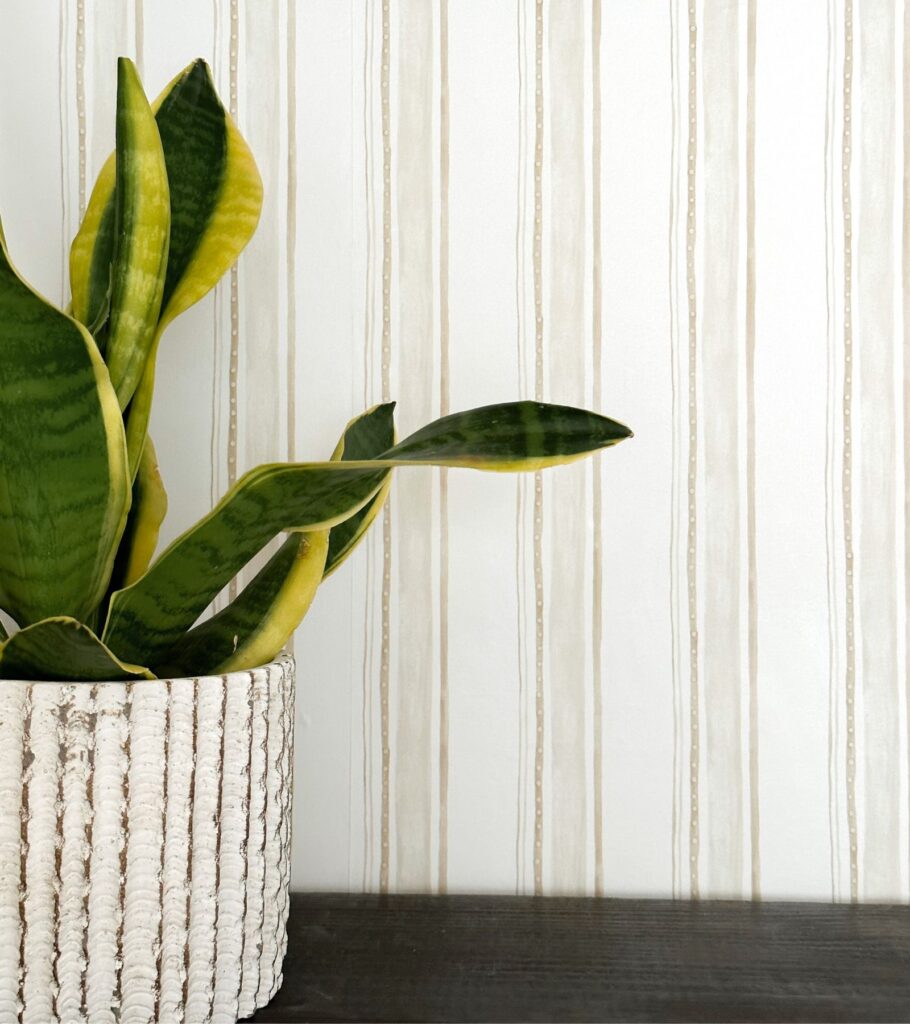
Best Places to Buy Cute Traditional Wallpaper:
Is Wallpaper Back In Style?
As I love to say, wallpaper is back baby! It has truly made a comeback and for good reason. It’s becoming something that designers are bringing back into their plans as it elevates a room that lacks personality!
Wallpaper got a bad rap because of its ornate floral designs and overuse in the 70s-80s. Wallpaper would cover entire rooms (and even entire houses), making for pattern overload.
With home decor being at the forefront of everyone’s minds today, wallpaper is used in a totally different way, with thousands upon thousands of designs to choose from. It doesn’t matter what style your house is, what colors you love, or what patterns describe you best, there is something out there for everyone!
I use wallpaper for accents and focal points! I think it’s important to remember dense patterns that have a lot going on can look really good on a wall or two, but they might be a bit overwhelming if you cover every wall with them. Simpler patterns are best used for covering the full room.
Also, a simple pattern is best in a small space to keep the room from feeling overcrowded. A dense pattern in a small room may feel a little suffocating.
Regardless of your wallpaper plans, no need to fret if wallpaper is “in” – it totally is and it’s never been better!
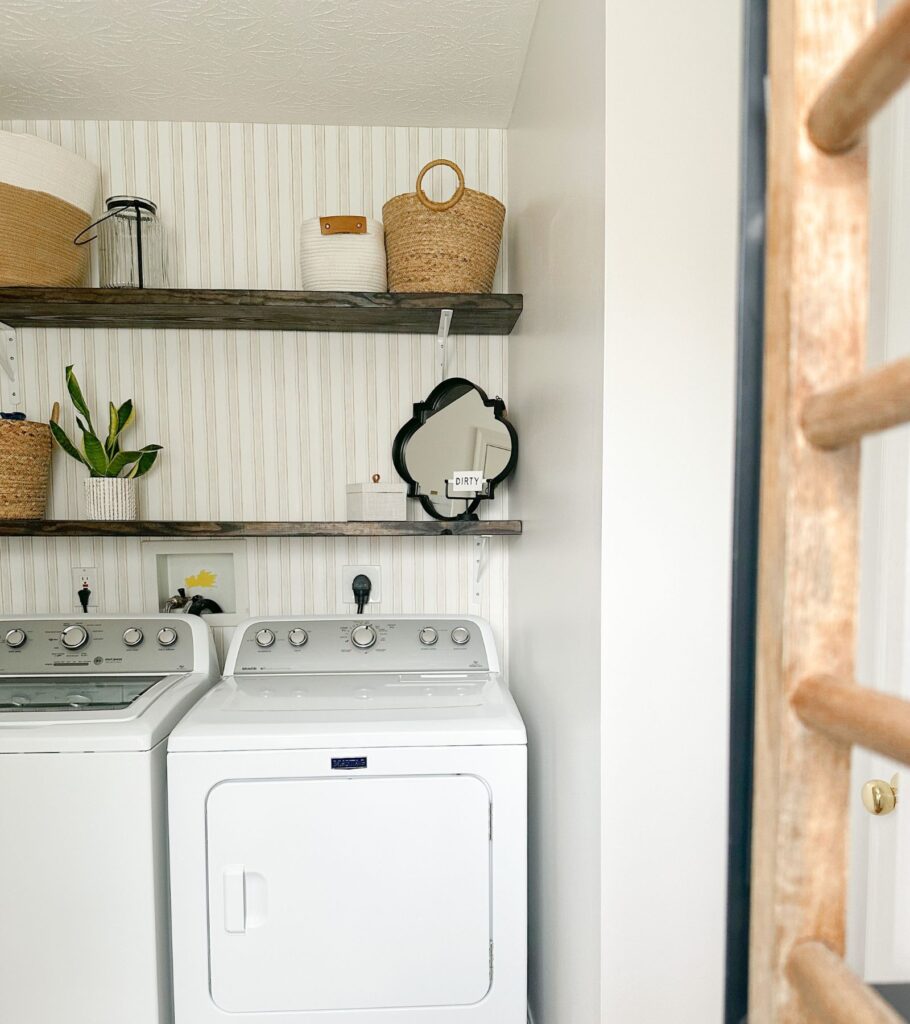
Best Material for Wallpaper
Vinyl is the best wallpaper material for its longevity. Vinyl is super durable and hard to rip during installation. This makes it stand the test of time and wear and tear throughout the years.
This isn’t to say that other materials aren’t as good – because materials such as linen are super popular as well! Linen wallpaper tends to add a little more luxury and warmth to a room.
As long as your wallpaper has good backing (which wallpaper today usually does), you shouldn’t have to worry about the material you are getting. Essentially it’s a preference thing, but chances are you will buy based on the pattern and vibe over the material!
What Is Prepasted, Water Activated Wallpaper and Should I Consider It?
Prepasted wallpaper is wallpaper that already has a paste embedded into itself, and it is activated by water. Sometimes people lump in peel and stick with prepasted wallpaper, but for the purposes of explaining, I’m specifically talking about the kind that requires water.
So based on the instructions, you may spray the backing of the wallpaper to activate the stickiness, or even dunk it in water!
For example, I’m using a paintable beadboard wallpaper for my DIY built-in project, and the wallpaper is to be dunked in water. I will have to report back on how it goes, but this is another option for wallpaper.
It’s not as popular of an option as peel and stick or traditional mainly because as you can imagine, it’s a little bit messier than the other two options and you have to work a little quicker to prevent the paste from drying. But if this method sounds better to you, there’s no harm in giving it a try!
Best Wallpaper Installation Tools
I’ll make this extremely easy for you! Here are the best and most important tools to have on hand when installing wallpaper. When looking at peel-and-stick vs traditional wallpaper, it doesn’t matter which you have, you will 100% need to have these tools on hand!
- Exacto knife
- Smoothing tool
- Scissors
- Tape Measure
- Level
- Pencil
For applying paste and primer for traditional wallpaper, you will obviously need a paintbrush as well.
Luckily, there is a super cheap but amazing wallpaper tool kit on Amazon. It’s only a couple of bucks and comes with both an exacto knife and a smoothing tool!
These are absolutely the best wallpaper tools to have!
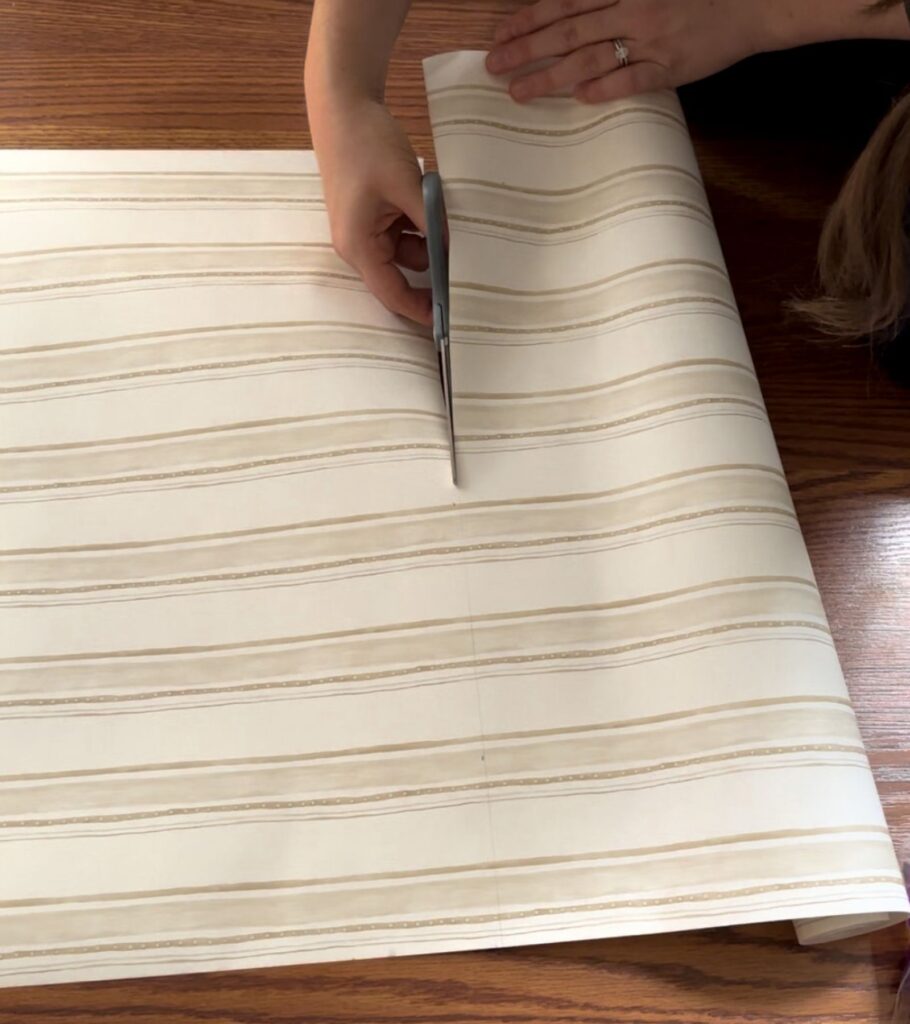
No one said installing wallpaper was going to be fun 🤣 But it is SO worth it in the end!
Hopefully, between my personal experience, personal mistakes LOL, and the pros and cons in this post, you now have some handy info on how to choose between peel-and-stick vs traditional wallpaper, and which is the best type of wallpaper for your home!
Happy wallpapering!

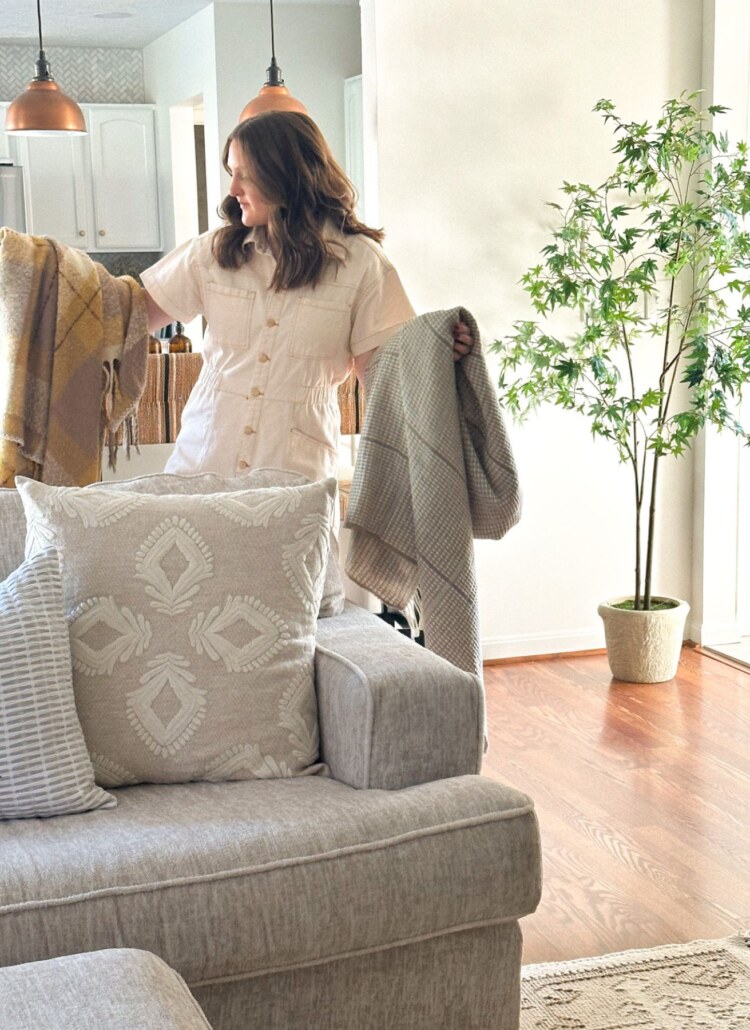
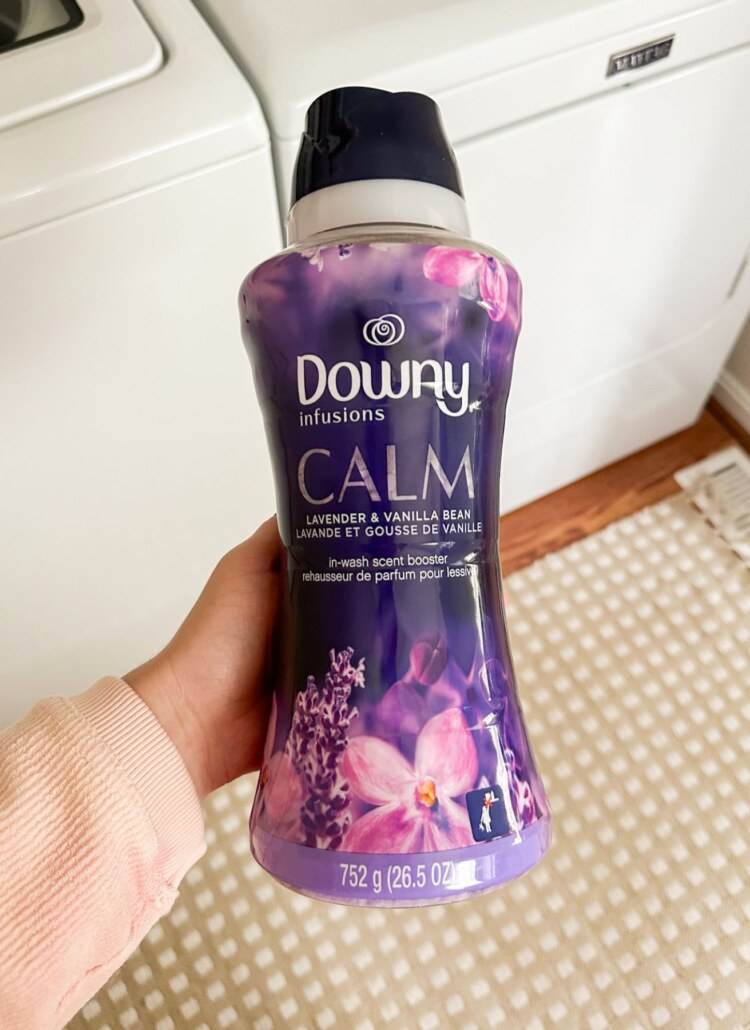
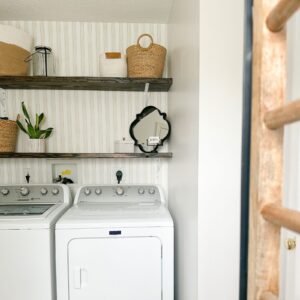
Leave a Reply